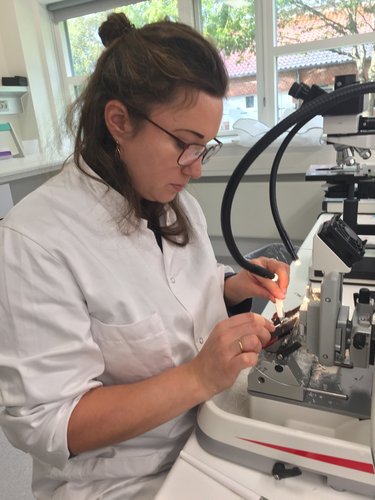Understanding E. coli infections: The impact of local inflammation
By Shaila Ann Sigsgaard
Darya Vodolazska, a postdoctoral researcher with a background in veterinary science, is currently engaged in the Nutrition Pillar of the PIG-PARADIGM project, funded by Novo Nordisk. Collaborating with Stine Karstenskov Østergaard, she is involved in a project, focusing on identifying the microbial community.
Their research primarily targets intestinal inflammation, aiming to generate knowledge that will contribute to the prevention of weaning-induced diarrhea in pigs.
“Specifically, we seek to understand the role of local inflammatory responses and their relationship with the structure and function of the piglet gut microbiome,” says Darya Vodolazska.
This microbiome and the epithelial cells have close interactions, which is a central theme of the PIG-PARADIGM project.
Vodolazska's project focuses on alterations in the mucosal and intestinal architecture and changes in the microbiome within the mucus layer, rather than the lumen. The goal is to identify specific biomarkers for local inflammation, which could be detected through blood or feces samples.
-They believe that local inflammation is a hallmark for the development of E. coli diarrhea, as it facilitates the colonization and spread of E. coli in the intestines.
The team aims to fill gaps in existing knowledge regarding how local inflammation affects the development or progression of E. coli infections. They are also aspiring to transfer the knowledge gained from pig studies to human patients suffering from inflammatory bowel diseases, such as ulcerative colitis and Crohn's disease. The research team hopes to be able to provide knowledge obtained from pig studies to human conditions, leveraging the similarities between pig and human functions and architectonics related to immunity and inflammatory responses. The opportunity to study both human and pig samples allows for a comprehensive understanding of these conditions.
To investigate this, they have developed a pig model that induces local inflammatory responses by exposing pigs to enterotoxigenic E. coli and dextran sodium sulfate, a chemical that induces inflammation. This controlled model ensures the presence of inflamed tissue in the pig gut before introducing E. coli, allowing for a comparison with control groups.
“The primary aim is to enhance piglet robustness and gut health, making them resilient to E. coli infections.”
The team successfully completed their animal trials last year and is currently analyzing the collected samples. They plan to present their findings at the annual PIG-PARADIGM meeting in May.
Darya Vodolazska
Post Doc
Department of Animal and Veterinary Sciences
Aarhus University
Research Topic: Gastrointestinal health, morphology and immunity of pigs. Intestinal inflammation and inflammatory markers
Email: dvs@anivet.au.dk

